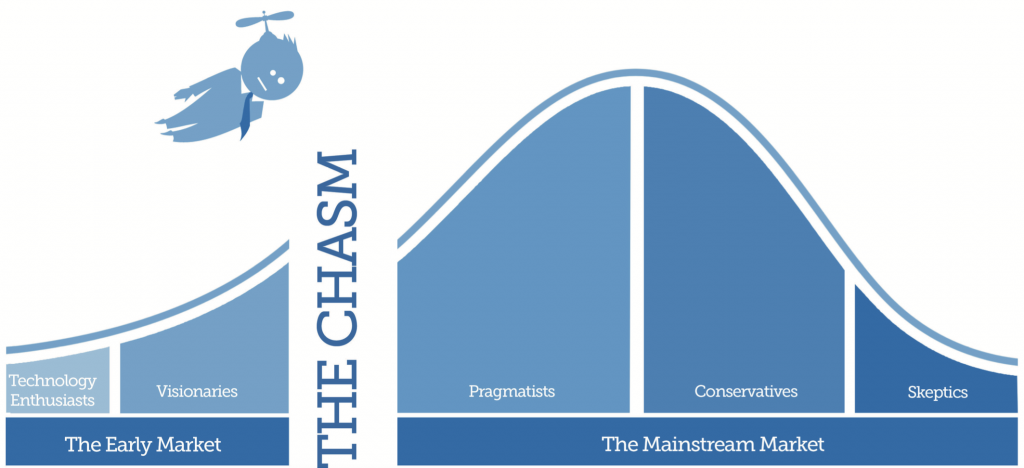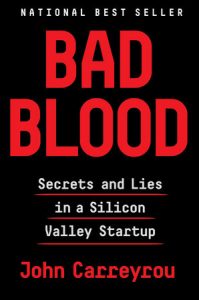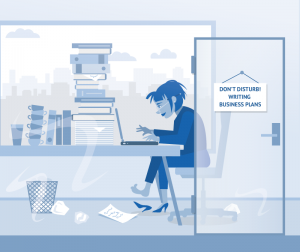Silicon Valley’s Rule Number One: Fake It Till You Make It
I do not think that “Fake It Till You Make It” is recommended. There are some fundamental values and virtues that you need to nurture when you do not have much else to show off.
Many years ago, I attended a meeting of the Silicon Vikings network. This network aims to establish links between the Nordic/Baltic countries and the bustling, entrepreneurial environment on the American west coast. One of the speakers, who explained what we northern Europeans could learn from the culture at the bottom of the San Francisco Bay, used an expression that I had not heard before:
Fake It Till You Make It
Translated to Danish, it would probably read: “cheat until you no longer have to”. It does not ring well in our local language, even though I have heard the expression many times since and have used it myself, it always appears in its original English wrapping.
Crossing the Chasm
The recommendation fell when the lecturer discussed the common challenge that most customers dislike doing business with new companies. Customers are conservative and afraid of making mistakes. Even though a new product from a new company may have many advantages, most customers would rather wait to buy, until others have proven that the products are working. Some companies will do the exact opposite, but they are, unfortunately, few and far between.

If you as a new company also offer new technology, then getting accepted by the market is twice as difficult.
Therefore, in Silicon Valley (and elsewhere), it is not unusual for startups to write bluechip company names on their reference list on their websites, even though they are not customers. It makes potential customers more comfortable, and ultimately supports your efforts with getting your products accepted on the market. For example, to write Coca-Cola on your customer list, even if they do not use the product, is almost risk-free. Coca-Cola is such a big company that nobody will notice. Also, should it be noticed by someone at Coca-Cola, you can always remove the name again.
Likewise, you can also pretend that your product can do a little bit more than it actually can. Before a new potential customer may make a purchase decision, a new version of the product will have caught up.
“Fake It Till You Make It” is an entirely legitimate approach, widely used and a harmless way to make it all go a little faster, easing market resistance.
Bad Blood: Secrets and Lies in a Silicon Valley Startup

What may seem like an innocent and harmless little trick can, however, evolve into the big catastrophe (and some smaller ones that I describe below).
In his book Bad Blood: Secrets and Lies in a Silicon Valley Startup, which tells the story about Theranos, the company that in a giant format pursued the “Fake It until You Make It” principle, the journalist and author John Carreyrou describes in detail how bad it may go when the little innocent guideline falls into the wrong hands and is taken to the extreme.
It is recommended reading that explains how quite a few American celebrities lost face, investors lost close to a billion dollars, customers buying into the idea lost some hundred million dollars and some of the patients who had their blood tested on the company’s devices got some very unpleasant surprises. That no one died as a result of Theranos’ interpretation of the “Fake It Till You Make It” principle is a miracle. Some of the employees still live with the trauma, and one committed suicide.
It started with a misunderstanding
The “Fake It Till You Make It” principle originates from the philosophy of positive thinking. It is a variation of the theory that you can do something, just by convincing yourself that you can do it. With concentrated effort, you can move to wherever you want to be. I do not deny that it works. I have often accepted to do things I haven’t done before and given adequate time to prepare I have delivered on my commitment.

However, it’s about cheating yourself – not cheating others.
In the Silicon Valley edition, the principle has been released among us and is used to legitimise a random, but seemingly carefully controlled and innocent play with the truth. However, where there are basically no limits to how much we can choose to fool ourselves, there are much tighter thresholds on how much we are allowed to fool others. We have a little more room for expressing our ambitions when making statements about the future (no one can predict the future). When we need to explain what we can do today and who our customers are, there should be no room for telling anything but the truth.
Optimism in Brøndby

In April 1989, I was offered the job as VP of sales and marketing for the startup company Mercante in the outskirts of Copenhagen. The company was not new. A previous version of the company’s printer had been sold by Philips under their name. Now Mercante was ready with a new design for their LED printer, had received 10 fresh millions (dollars) and wanted to launch globally under their own name.
Long story short: We were not successful. Despite our best efforts and a lot of hard work the new printer never managed to meet its own design specifications.
We did not deliberately run according to the “Fake It Till You Make It” principle, and we did not claim to have customers that we did not have, but we thought we could develop a product that we could not. We released the product for sale, while it was still full of errors, that we thought we could fix.
In hindsight it was a job I should never have accepted. But getting new customers and revenue for startups was my speciality, the remuneration and option package was attractive, investors had put millions into the project and renowned Philips had sold a previous version. What could possibly go wrong? I did not do my own due diligence but relied on other’s, and that was a big mistake.
The details of that story can be read here.
Emulating the human brain
I left Mercante just in time before the ship went down and worked for many years in companies that did not have the same problems in getting their products to work. There were always challenges, but on the whole, things fell into place and customers were happy.
I’d just returned from four years in Germany, and considering starting my own business, when I was contacted by a headhunter in August 2001. An investor had allocated 2 million dollars to an entrepreneur who had developed a groundbreaking product. The entrepreneur was the nerdy type who did not want to mess with business development and administration and therefore wanted a CEO experienced with startups on his team.
After the first meeting, I made three conclusions:
- The company didn’t need a CEO. There is not much to manage in a company with 10 developers, a receptionist and a part-time bookkeeper.
- The company had not developed a product. They had an idea of a product that they were now setting out to develop.
- There was a high probability that the product could not be completed with the allocated capital. Pinpointing how much time and money it takes to develop something the world hasn’t seen before is downright impossible.

We, therefore, put a deal together where I, on paper, was the CEO, but my tasks were to revise the business plan and prepare a new round of funding.
Novamind, as the company was called, had ideas for developing a technology (software) that could generate 3D geometry and texture from regular movie footage. With a handheld HD camcorder, you could record a movie of the subjects you wanted to transform into a 3D model. Anything. People, buildings, cities, landscapes, mountains. Anything.
Software that can generate a representation of 3D geometry and texture from 2D images must have roughly the same experience base as the human brain. When is a shadow not just a different colour, when is a reflection not an independent image, when does something bend and when does it bulge? When we see three dimensions in 2D images, it’s only because our brain has learned that the reality looks like that. Could this experience be built into a piece of software?
Revising the business plan

The business case for the first round of funding (the $2M) was to pitch a replacement of the 360-degree images that real estate agents used in their web ads.
It took only a couple of conversations with selected real estate agents to abandon that premise. The real estate agents were pleased with the 360-degree images, and there was a well-established service to get them done, the price was low, and there was no obvious value-add in replacing them. Overall, real estate agents didn’t believe that a 3D representation of a house would make it sell faster or bring in a higher price.
Searching the web I came across a small consultancy in Texas specializing in the 3D market, and with them, we explored various market segments without the potential customers getting to know who we were. That way we could present a multitude of product specifications and get their response to usability. You have to take that kind of feedback, where customers do not have to put money on the table, with a grain of salt, but we did not want to raise any expectations before we knew how far we could get for the two million dollars.
Stop before the game becomes dangerous
After six months, the following was clear:
- The movie industry was seriously interested in and prepared to pay even very big sums for the technology – if it really could be based on ordinary HD video.
- Developing the technology to deliver on a specification that would satisfy the movie industry would cost an additional $10+ million in software development and a few more million in developing dedicated hardware.
- For the $2 million we had already received, a scaled-down version to produce a 3D representation of smaller objects could be completed. However, there was already some competition and very low price points in this market segment.
We were unable to find investors who were interested in either Model 2 or Model 3.
We wrapped up the company. The investors lost their money, The Employers Guarantee Fund paid the employees their severance packages (typically 3 months salary) and computers and furniture was sold to honour our few creditors.
You can make mistakes and fail, but don’t compromise your integrity

Startups, based on new technology that the world hasn’t seen before, are associated with significant risk. In the well-known survey of why startups fail, some of the most common reasons are that there is no market for the product, running out of money, being unable to compete and the product is bad.
I do not think that “Fake It Till You Make It” is recommended. There are some fundamental values and virtues that you need to nurture when you do not have much else to show off. Lying is contagious, and soon you do not know who and what to trust. It makes investors, employees and customers uncertain. And if you first said an untruth, you often get tempted to build on top of it instead of defusing it.
Elizabeth Holmes and Theranos are an excellent example of how wrong it can go. If you refrain from entering this alley, you have actually eliminated a risk.








